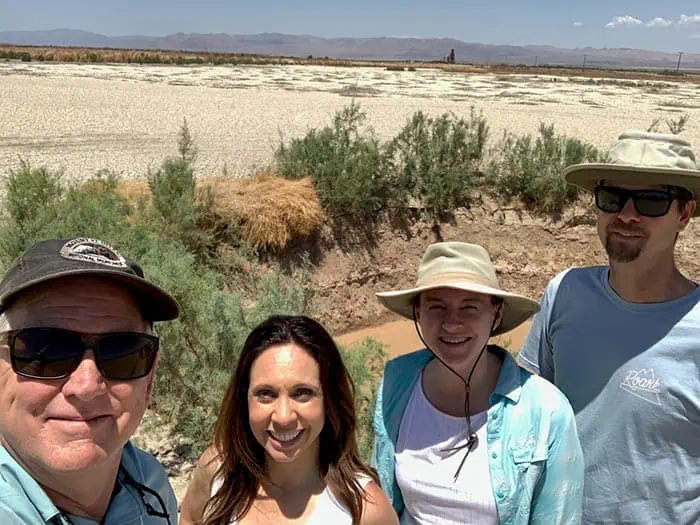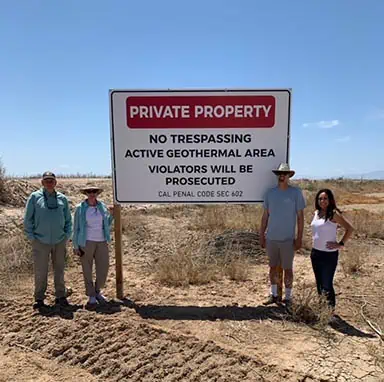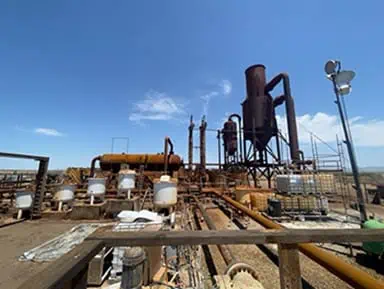



Early one Saturday morning, SCSers Chuck Houser, Luke Montague, Allison O’Neal, and me, Jen Morton, headed out to Brawley in the Imperial Valley region of Southern California. That is the desert. We had been having our usual May Gray here in SoCal when the summer can feel like winter at the coast, but the desert was a balmy 100 degrees and sunny that day.
We met with Sean Wilcock of the Imperial Valley Economic Development Corporation, one of our clients for Brownfields work, at a coffee shop in Brawley. From there, we ventured north to an area between Calipatria and Niland to see the beginning workings of a lithium extraction operation.
This region lies at the southern end of the San Andreas fault, where the motion between the North American and Pacific Plates begins to switch from strike-slip to extensional or from side-by-side to pulling apart. Where extension occurs, the crust tends to be relatively thin. Imagine pulling apart a sticky bun or taffy – the middle starts to get thinner before it breaks.
With the thinning of the crust, hot magma from the earth’s interior is closer to the surface. The heat from the magma heats the groundwater, which is A LOT beneath the Imperial Valley. And in this groundwater are minerals that, until recently, have not necessarily been worth the effort to extract from the water.
For decades energy companies have been using this super-heated water to generate electricity in the Imperial Valley. The hot water is pumped up from deep within the earth, using the steam to rotate turbines. The water is then pumped back into the aquifer.
Before our trip, Chuck and I met Tracy Sizemore, director of Battery Operations for Controlled Thermal Resources (CTR), at a San Diego Association of Geologists (SDAG) meeting learning more about the mineral resources in Imperial Valley. Chuck and I were as fascinated with that as the opportunity to see the biggest drill rig we’ve ever seen, which would be drilling an 8,000-foot well for groundwater extraction. We learned about the brine’s lithium resources (another term for the super-heated, mineral-rich groundwater).
Lithium has become a highly sought-after metal with the proliferation of electric vehicles. Given this increase in value, it is now economically feasible to extract it from the brine as part of the energy generation process. Some companies have plans to conduct the extraction in addition to electricity generation at existing geothermal plants. One company will build a separate extraction facility next to an existing plant.

CTR is planning to develop a plant that will focus primarily on the extraction of lithium, with energy generation being secondary. As Geologists, we got a tour of CTR’s prototype plant. It was fascinating to see all of the equipment and the results of the extraction process – a small bottle of lithium-rich liquid worth about $10. The extraction process also creates a sludge containing other important elements, including manganese, zinc, and even gold and silver. The plan is to sell the sludge to another company to extract the additional economic elements.
The process of extracting lithium in this manner is sustainable and much cleaner than traditional mining methods. It is also considered carbon-neutral. The new plant will generate enough electricity to power it 100%, with enough left over to power a battery manufacturing facility next door after its construction.
CTR’s lithium extraction process expects to bring 1,400 jobs to the area, with another 4,000 jobs once the battery plant is up and running. With the influx of workers, the Imperial Valley needs more infrastructure, housing, and services, so it is supporting economic growth.
In the fall, we plan to return to CTR’s facility to see the enormous rig drilling the 8,000-foot well!
Meet the Author – Jen Morton, Professional Geologist and SCS Project Manager
Consider a position with the finest pure-environmental firm in North America!